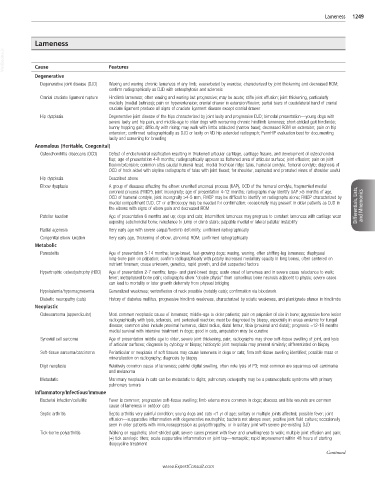Page 2503 - Cote clinical veterinary advisor dogs and cats 4th
P. 2503
Lameness 1249
Lameness
VetBooks.ir Cause Features
Degenerative
Degenerative joint disease (DJD) Waxing and waning chronic lameness of any limb; exacerbated by exercise; characterized by joint thickening and decreased ROM;
confirm radiographically as DJD with osteophytosis and sclerosis
Cranial cruciate ligament rupture Hindlimb lameness; often waxing and waning but progressive; may be acute; stifle joint effusion; joint thickening, particularly
medially (medial buttress); pain on hyperextension; cranial drawer in extension/flexion; partial tears of caudolateral band of cranial
cruciate ligament produce all signs of cruciate ligament disease except cranial drawer
Hip dysplasia Degenerative joint disease of the hips characterized by joint laxity and progressive DJD; bimodal presentation—young dogs with
severe laxity and hip pain, and middle-age to older dogs with worsening chronic hindlimb lameness; short-strided gait hindlimbs;
bunny hopping gait; difficulty with rising; may walk with limbs adducted (narrow base); decreased ROM on extension; pain on hip
extension; confirmed radiographically as DJD or laxity on VD hip extended radiograph; PennHIP evaluation best for documenting
laxity and screening for breeding
Anomalous (Heritable, Congenital)
Osteochondritis dissecans (OCD) Defect of endochondral ossification resulting in thickened articular cartilage, cartilage fissure, and development of osteochondral
flap; age of presentation 4-8 months; radiographically appears as flattened area of articular surface; joint effusion; pain on joint
flexion/extension; common sites caudal humeral head, medial trochlear ridge talus, humeral condyle, femoral condyle; diagnosis of
OCD of hock aided with skyline radiographs of talus with joint flexed; for shoulder, supinated and pronated views of shoulder useful
Hip dysplasia Described above
Elbow dysplasia A group of diseases affecting the elbow: ununited anconeal process (UAP), OCD of the humeral condyle, fragmented medial
coronoid process (FMCP), joint incongruity; age of presentation 4-12 months; radiographs may identify UAP >5 months of age,
OCD of humeral condyle, joint incongruity >4-5 mm, FMCP may be difficult to identify on radiographs alone; FMCP characterized by
medial compartment DJD, CT or arthroscopy may be needed for confirmation; occasionally may present in older patients as DJD in Differentials, Lists,
the elbows with signs of elbow pain and decreased ROM and Mnemonics
Patellar luxation Age of presentation 6 months and up; dogs and cats; intermittent lameness may progress to constant lameness with cartilage wear
exposing subchondral bone; reluctance to jump or climb stairs; palpable medial or lateral patellar instability
Radial agenesis Very early age with severe carpal/forelimb deformity; confirmed radiographically
Congenital elbow luxation Very early age, thickening of elbow, abnormal ROM; confirmed radiographically
Metabolic
Panosteitis Age of presentation 5-14 months; large-breed, fast-growing dogs; waxing, waning, often shifting-leg lameness; diaphyseal
long-bone pain on palpation; confirm radiographically with patchy increased medullary opacity in long bones, often centered on
nutrient foramen; cause unknown, genetics, rapid growth, and diet suspected factors
Hypertrophic osteodystrophy (HOD) Age of presentation 2-7 months; large- and giant-breed dogs; acute onset of lameness and in severe cases reluctance to walk;
fever; metaphyseal bone pain; radiographs show “double physis” from cancellous bone necrosis adjacent to physis; severe cases
can lead to mortality or later growth deformity from physeal bridging
Hypokalemia/hypomagnesemia Generalized weakness; ventroflexion of neck possible (notably cats); confirmation via bloodwork
Diabetic neuropathy (cats) History of diabetes mellitus, progressive hindlimb weakness, characterized by sciatic weakness, and plantigrade stance in hindlimbs
Neoplastic
Osteosarcoma (appendicular) Most common neoplastic cause of lameness; middle-age to older patients; pain on palpation of site in bone; aggressive bone lesion
radiographically with lysis, sclerosis, and periosteal reaction; must be diagnosed by biopsy, especially in areas endemic for fungal
disease; common sites include proximal humerus, distal radius, distal femur, tibia (proximal and distal); prognosis ≈12-18 months
medial survival with intensive treatment in dogs; good in cats, amputation may be curative
Synovial cell sarcoma Age of presentation middle age to older, severe joint thickening, pain; radiographs may show soft-tissue swelling of joint, and lysis
of articular surfaces; diagnosis by cytology or biopsy; histiocytic joint neoplasia may present similarly; differentiated on biopsy
Soft-tissue sarcoma/carcinoma Periarticular or neoplasia of soft tissues may cause lameness in dogs or cats; firm soft-tissue swelling identified; possible mass or
mineralization on radiography; diagnosis by biopsy
Digit neoplasia Relatively common cause of lameness; painful digital swelling, often note lysis of P3; most common are squamous cell carcinoma
and melanoma
Metastatic Mammary neoplasia in cats can be metastatic to digits; pulmonary osteopathy may be a paraneoplastic syndrome with primary
pulmonary tumors
Inflammatory/Infectious/Immune
Bacterial infection/cellulitis Fever is common; progressive soft-tissue swelling; limb edema more common in dogs; abscess and bite wounds are common
cause of lameness in outdoor cats
Septic arthritis Septic arthritis very painful condition; young dogs and cats <1 yr of age; solitary or multiple joints affected; possible fever; joint
effusion—suppurative inflammation with degenerative neutrophils; bacteria not always seen; positive joint fluid culture; occasionally
seen in older patients with immunosuppression as polyarthropathy; or in solitary joint with severe pre-existing DJD
Tick-borne polyarthritis Walking on eggshells; short-strided gait; severe cases present with fever and unwillingness to walk; multiple joint effusion and pain;
(+) tick serologic titers; acute suppurative inflammation on joint tap—nonseptic; rapid improvement within 48 hours of starting
doxycycline treatment
Continued
www.ExpertConsult.com

